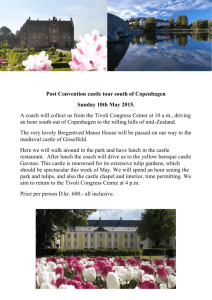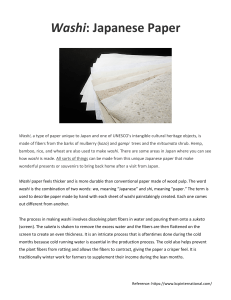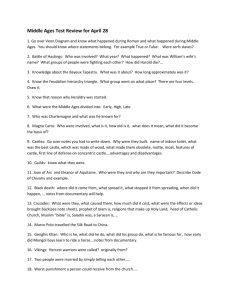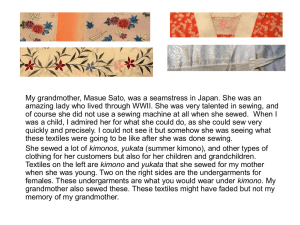Japan Video Topics 2006/08
advertisement
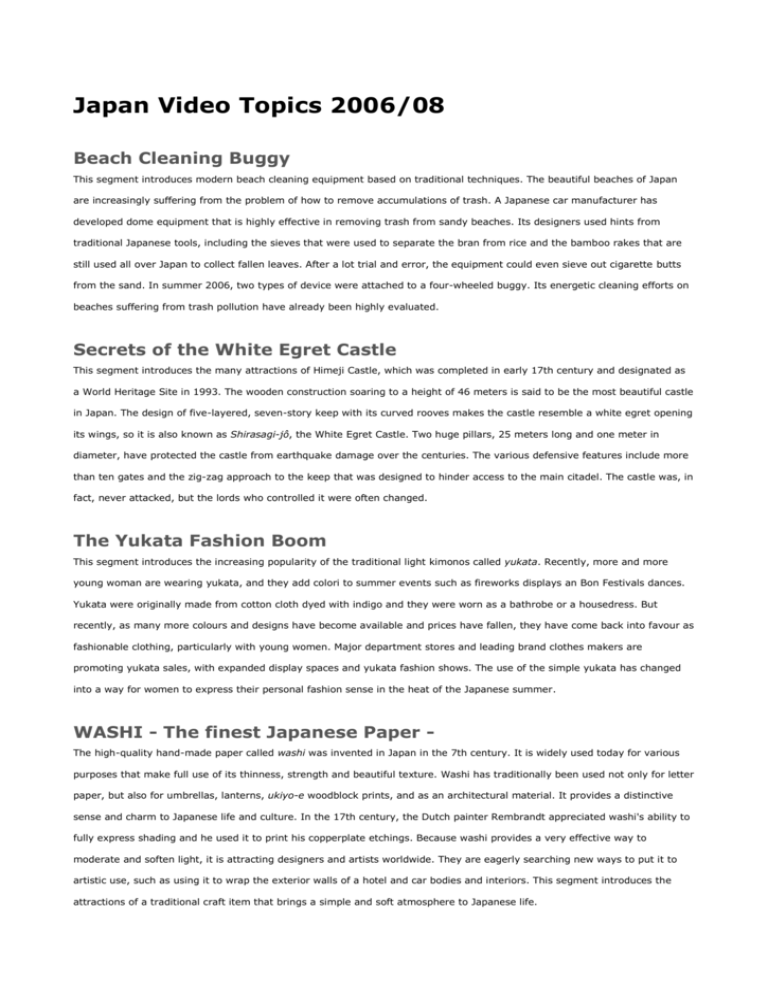
Japan Video Topics 2006/08 Beach Cleaning Buggy This segment introduces modern beach cleaning equipment based on traditional techniques. The beautiful beaches of Japan are increasingly suffering from the problem of how to remove accumulations of trash. A Japanese car manufacturer has developed dome equipment that is highly effective in removing trash from sandy beaches. Its designers used hints from traditional Japanese tools, including the sieves that were used to separate the bran from rice and the bamboo rakes that are still used all over Japan to collect fallen leaves. After a lot trial and error, the equipment could even sieve out cigarette butts from the sand. In summer 2006, two types of device were attached to a four-wheeled buggy. Its energetic cleaning efforts on beaches suffering from trash pollution have already been highly evaluated. Secrets of the White Egret Castle This segment introduces the many attractions of Himeji Castle, which was completed in early 17th century and designated as a World Heritage Site in 1993. The wooden construction soaring to a height of 46 meters is said to be the most beautiful castle in Japan. The design of five-layered, seven-story keep with its curved rooves makes the castle resemble a white egret opening its wings, so it is also known as Shirasagi-jô, the White Egret Castle. Two huge pillars, 25 meters long and one meter in diameter, have protected the castle from earthquake damage over the centuries. The various defensive features include more than ten gates and the zig-zag approach to the keep that was designed to hinder access to the main citadel. The castle was, in fact, never attacked, but the lords who controlled it were often changed. The Yukata Fashion Boom This segment introduces the increasing popularity of the traditional light kimonos called yukata. Recently, more and more young woman are wearing yukata, and they add colori to summer events such as fireworks displays an Bon Festivals dances. Yukata were originally made from cotton cloth dyed with indigo and they were worn as a bathrobe or a housedress. But recently, as many more colours and designs have become available and prices have fallen, they have come back into favour as fashionable clothing, particularly with young women. Major department stores and leading brand clothes makers are promoting yukata sales, with expanded display spaces and yukata fashion shows. The use of the simple yukata has changed into a way for women to express their personal fashion sense in the heat of the Japanese summer. WASHI - The finest Japanese Paper The high-quality hand-made paper called washi was invented in Japan in the 7th century. It is widely used today for various purposes that make full use of its thinness, strength and beautiful texture. Washi has traditionally been used not only for letter paper, but also for umbrellas, lanterns, ukiyo-e woodblock prints, and as an architectural material. It provides a distinctive sense and charm to Japanese life and culture. In the 17th century, the Dutch painter Rembrandt appreciated washi's ability to fully express shading and he used it to print his copperplate etchings. Because washi provides a very effective way to moderate and soften light, it is attracting designers and artists worldwide. They are eagerly searching new ways to put it to artistic use, such as using it to wrap the exterior walls of a hotel and car bodies and interiors. This segment introduces the attractions of a traditional craft item that brings a simple and soft atmosphere to Japanese life. The popular Tokyo English Bus Tour Yellow "Hato Bus" sightseeing buses take tourists to many sightseeing spots in Tokyo, Japan's capital city. Around 70,000 people a year enjoy sightseeing using the buses that provide an English commentary, a service that began in 1953. It is a very easy and comfortable way to see the Tokyo sights. The tours are led by female guides proficient in English who all have their own techniques to subtly change their explanations according to the nationality and cultural background of the tour members. Their efforts are always well-received. In this segment we joint one of the popular bus tours that includes visits to the major sightseeing spot of Meiji Shrine, Odaiba and Asakusa.





